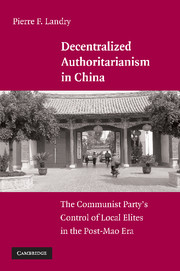 Decentralized Authoritarianism in China
Decentralized Authoritarianism in China Book contents
- Frontmatter
- Contents
- List of Tables
- List of Figures
- Acknowledgments
- List of Abbreviations
- Decentralized Authoritarianism in China
- 1 Authoritarianism and Decentralization
- 2 Organizing Decentralization
- 3 Promoting High-Level Generalists: The Management of Mayors
- 4 Organizational Power: The View from Within
- 5 Explaining Cadre Rank
- 6 The Impact of Village Elections on the Appointment of Party Branch Secretaries
- 7 Conclusion
- References
- Index
2 - Organizing Decentralization
Published online by Cambridge University Press: 22 July 2009
- Frontmatter
- Contents
- List of Tables
- List of Figures
- Acknowledgments
- List of Abbreviations
- Decentralized Authoritarianism in China
- 1 Authoritarianism and Decentralization
- 2 Organizing Decentralization
- 3 Promoting High-Level Generalists: The Management of Mayors
- 4 Organizational Power: The View from Within
- 5 Explaining Cadre Rank
- 6 The Impact of Village Elections on the Appointment of Party Branch Secretaries
- 7 Conclusion
- References
- Index
Summary
Any government contemplating decentralization must choose a few key parameters that are crucial to the relationship between the center and the localities. It can set the number of layers of local governments; it can decide how various types of local governments interact with each other: Should they form a nested hierarchy or should each level have well-defined responsibilities independently of each other? Finally, in an authoritarian regime that does not hold local elections, the center can set the lower boundary of the “reach of the State” (Shue, 1988). Critical to this reach is the lowest level of government that is directly under central authority. If the center appoints everybody, the system is completely centralized, but the costs of monitoring local agents are likely to be high in a large geographical expanse like China. A fully centralized system can pretend to control everything, but it may overextend its reach and control very little in practice. Overly centralized systems also stifle economic growth. On the other hand, if the center manages too few agents, its monitoring costs are likely to be lower, but the agents will acquire considerable de facto resources and authority under this decentralized regime, and thus become potential challengers to central authority.
In post-1978 China, personnel management has been a central element in loosening these seemingly contradictory constraints.
- Type
- Chapter
- Information
- Decentralized Authoritarianism in ChinaThe Communist Party's Control of Local Elites in the Post-Mao Era, pp. 37 - 79Publisher: Cambridge University PressPrint publication year: 2008


